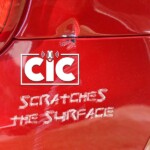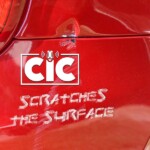
CIC Scratches the Surface of Bad Repairs, Pretty Paint, AI & More
Published in Hammer & Dolly – Thomas Greco Publishing
Typically, the focus of collision repair professionals’ is to fix what’s damaged, restoring vehicles to their pre-accident condition. But during the most recent Collision Industry Conference (CIC), held in Palm Springs, CA in conjunction with other industry meetings, industry professionals took things a step further as committees repositioned themselves to tackle common topics from new angles.
 And although the full day of back-to-back presentations surely got attendees thinking, it’s mind-blowing to realize that CIC merely scratched the surface in these discussions which are certain to continue playing a role in the industry for years to come.
And although the full day of back-to-back presentations surely got attendees thinking, it’s mind-blowing to realize that CIC merely scratched the surface in these discussions which are certain to continue playing a role in the industry for years to come.
What’s the cost of a bad repair? The OEM Relations Committee explored how to mitigate risk by addressing substandard repairs in order to help protect the manufacturer’s brand. “When there’s a poor repair experience, that can leave the customer with a negative brand impression,” explained Committee Co-Chair Liz Stein (OEC). “But that same repair experience can have multiple negative consequences, not only for the consumer, but for every other stakeholder in the business, so we wanted to examine the safety and economic repercussions of a substandard repair.”
Each example began as a vehicle repaired at a legitimate facility, but the vehicle owner found something that concerned them, so they took their car to another facility to be examined or re-repaired. Of the 26 studied vehicles that were taken in for such a post-repair inspection, over 90 percent wound up being totaled after an independent post-repair inspector uncovered substandard repairs, and around 50 percent had moderate to severe frame damage that had not been addressed in the initial repair. The secondary repair cost an average of 3.5 times the original estimate.
A 2016 Subaru WRX with an initial estimate of $7,000 was first brought in for an inspection due to a poor paint job – masking lines, inclusions in the paint and the wrong paint altogether – but much more was uncovered. Although the customer was billed for frame work, there was no evidence of clamp marks, and the steering column had not been addressed as instructed by the OEM. Numerous poor-quality aftermarket and used parts had been utilized, causing fitment issues. With a secondary repair cost of $18,500, the vehicle was declared a total loss.
As the committee presented several additional case studies, a common theme became apparent. “What is the vehicle owner’s perception?” asked Co-Chair Ron Reichen (Precision Body & Paint). “It’s the first thing they see, so the majority of the time, the process started because of inclusions in the paint or paint color match. That starts the process because they don’t see what’s underneath the onion, but those paint flaws raise a red flag.”
But those paint flaws weren’t the only consistencies apparent among the case studies. “The lack of pre and post-repair inspections was prevalent. Lack of a pre-alignment, let alone a secondary alignment after the repairs. Calibrations were just simply overlooked, and there was a failure to recognize OE repair procedures, which all boils down to not following a defined process,” he continued, stressing, “If you have a proper blueprint and accountability within the repair process, you have a much better chance of a predictable outcome.”
Such scenarios create negative experiences for the consumer but also for the employees that left panelists wondering how some of these vehicles made it out of a shop, not just once but often multiple times. “One of these vehicles, the customer had gone back to the original shop nine times,” recalled Erin Solis (Certified Collision Group). “How does it get out of there in the first place? But then, it also got out of there a second, third, fourth time…the customer kept coming back, and it was still blatantly wrong.”
Even more frightening is the reminder that only 26 vehicles were studied. “Any of these vehicles could have resulted in an experience like the Honda Fit in Texas [in the John Eagle case], but these 26 vehicles are just a small fraction of what is out there on the streets,” Reichen pointed out. “And where did those total loss vehicles go? Were they crushed, or did they end up back on the roads again? How many more of those vehicles are out there? It should be terrifying to all of us because those vehicles are coming at us and our families.”
Acknowledging that it’s easy to forget the empty chair, which CIC reserves as a reminder to keep the vehicle owner in mind, when looking at statistics, Stein directed the conversation to solutions, recommending that shops educate customers and maintain professional communication throughout the process. She also stressed the importance of being properly trained, tooled and equipped for every repair and always accessing OEM repair information.
“Have a quality control process in place,” she reiterated. “And always make sure that no matter what, your people are empowered at any point in the process to be able to stop and say, ‘This isn’t right,’ to call a timeout and send it back to the technician without being penalized for stopping the process. There needs to be an inspection with checklists and processes for ensuring all necessary procedures were followed.”
In response to attendees’ questions, committee members confirmed that the vehicles were all repaired at legitimate, licensed facilities, though none of the vehicles Solis reviewed had initially been repaired at an OEM-certified collision center. In addition to observing an absence of calibrations and scans on the repair plans, inspectors also noticed a pattern of denial by bill payers when calibrations were requested.
“The solution starts at the beginning,” Reichen added. “We, as an entire industry, have to recognize that we are no longer in a trade. We are a skilled profession, and we need to start acting like it.”
Paint flaws may have alerted vehicle owners to the need for a post-repair inspection in those case studies, but with the multitude of ADAS equipped on modern vehicles, paint is more than merely decorative, as the Parts and Materials Committee set out to explain from the perspectives of an OEM, two paint manufacturers and a shop manager.
Showing an image of the many systems one of his company’s vehicles could be equipped with, Benito Cid (Mercedes-Benz USA) emphasized that sensors “require a clear line of sight,” comparing it to a person walking around. “You’re seeing and hearing things that help you make decisions on what you’re going to do. The car uses these radar sensors to make those decisions.
“The importance of making sure the systems function properly is not just where the cameras are pointed or if they are mounted in the right place. Those things are important, but now, a big part that was really not thought of as much before is how much paint is on it? What color is on it? Some technology has limitations on not just how much paint you can put on but if it can be repainted at all, and the only way to know how to work on it properly is by accessing the repair procedures.”
AkzoNobel’s Ryan Brown agreed that it’s imperative for repairers to always research the OEM’s manual, even on what one might consider a “simple” paint job. “Paint has always been cosmetic; it is no longer just cosmetic. It is also part of the safety system, and we need to recognize that and make sure we’re taking the proper steps to repair the car correctly for the customer.”
While the OEM is responsible for creating repair manuals and granting access to them, it’s the repairer’s responsibility to obtain and adhere to the required repair methods. He identified several factors that exert influence on radar sensors, such as material thickness of the substrate. Primer and clearcoat have limited impact on transmission, but no blending is allowed in the radar zone since this disrupts the signal. Additionally, bodyfiller application, welding and repair to the plastic substrate is not allowed. No manual tinting or color correction of the approved color is allowed.
Jeff Wildman (BASF) began by observing that there are thousands of different colors that can impact radar, and those colors are different for every manufacturer. Likewise, every OEM has their own radar specification, and it’s imperative to research the repair procedures and ensure use of the right formula during a refinish.
“You cannot blend over that radar,” Wildman noted. “But a lot of times, you may not be able to paint that bumper without blending into the quarter, and that is something you want to know early on in the repair process. It’s really important that you think about these things in advance.”
BMW has published very clear guidance on refinishing near sensors, according to Andrew Batenhorst (Pacific BMW Collision Center), who shared the OEM’s flowchart of repair plan considerations and acknowledged that he most often sees the third process where bumpers are replaced; however, he believes the most important factor is simply having a consistent process and standard. “If you have a repair planning process in your shop, no process can exist without having a standard. And if each time you’re assessing damage to a vehicle, you’re assessing it in a different way and different people are interpreting the process in a different way, you’re not going to get a consistent work product at the end of the repair.
“We are not perfect by any means,” he admitted. “We’ve made mistakes in the past that have been very painful, and we replaced bumpers when we did it wrong. So we learned quickly that if each person is interpreting what needs to be done in a different way, we’re not going to land where we need to land. We’re wasting money and the customer’s time. By having this standard in place, it’s a benchmark. It’s a measurement tool, and it helps keep everybody rowing the boat in the same direction.”
Establishing processes and standards is one method for solving some of the problems shops encounter, but the Emerging Technologies Committee offered a high-level overview of AI (artificial intelligence), which was defined, “at its simplest form” as being “a field which combines computer science and robust datasets to enable problem solving.”
AI has a lot of potential uses in the automotive space, but Committee Co-Chair Chuck Olsen (AirPro Diagnostics) emphasized the quality of an AI program – like with any computer program – is contingent on its inputs. “Garbage in, garbage out. If you have a bad program or train AI with inaccurate information, it will give incorrect answers every time. The model is dependent on its inputs; it perceives the world based on how it is programmed. And if used properly, it can be a tool for us to use in the future.”
Co-Chair Bob Augustine (Opus IVS) added, “AI is built on a model that is continuously being tuned based on feedback from the humans who help train it.”
Panelists all agreed that the human element remains important, stressing that the AI model is unable to employ common sense, so it will never be 100 percent perfect and will always rely on an ethical human to make a final decision.
“AI helps you make decisions,” James Spears (Tractable) offered input. “It should be very fast, accurate and reputable.”
Still, AI utilization presents many opportunities for the industry, from analyzing DTCs to assisting with training and even organizing service information for easier review.
“There’s a lot of AI around us, and we need to embrace it,” contributed Scott Brown (Diagnostic Network), who shared information on his company’s AI bot, AiDN, which was designed to think like a technician and respond to questions to provide “a starting point on where to go to properly triage a problem” as a means of enhancing efficiency in the shop.
Of course, the most effective way to improve shop efficiencies starts at the beginning of the process with repair planning, and it’s helpful to stay on top of any p-page update, which is why Estimating and Repair Planning Committee Chair Danny Gredinberg (Database Enhancement Gateway) provided a detailed overview of the estimating systems’ most recent p-page updates. Users of Audatex, CCC and Motor can access the P-pages through their platforms, but non-users can also review the P-pages for any of the three information providers (IP) by going to degweb.org, selecting “estimators toolbox,” then clicking on “estimating systems” and choosing the specific IP.
Gredinberg examined the recent P-pages in detail; view his complete presentation at ciclink.com/meeting-presentations.
Although the information shared at CIC was invaluable, everyone knows it’s not very useful if the collision industry doesn’t start attracting more young talent into shops. During a special presentation by the Talent Pool and Education Committee, “Collisionista” Petra Schroeder and Charlie Robertson (Collision Career Institute) shared a new industry outreach video (available at bit.ly/rev-up-collision-career), which they hope will be used to offer young people a better view of the exciting career opportunities available in the collision repair industry.
CIC’s next meeting is scheduled for April 17, 2024 in Seattle, WA. Registration information, as well as presentations from previous meetings, can be found at ciclink.com.




